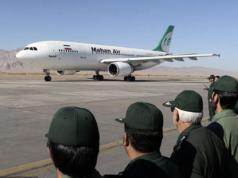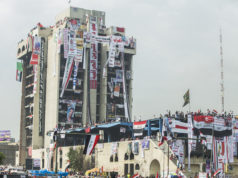As Iraq’s new leaders make painstaking decisions over what to do with Saddam-era symbols, one relic in particular will be most difficult to deal with: a 605-page Qur’an written in Saddam Hussein’s blood.
Over the course of two years in the late 1990s, Saddam sat regularly with a nurse who drew a total of 27 litres of blood from the dictator to be used as ink by an Islamic calligrapher to transcribe a Qur’an. Since the fall of Baghdad in 2003, the Blood Qur’an has remain locked behind vaulted doors in a Baghdad mosque.
Iraq’s leaders disagree on what to do with Saddam-era artifacts such as this one. On the one hand, the Iraqi government is sensitive to the re-emergence of symbols that may glorify the former regime and serve as an icon for its remaining supporters. On the other hand, some believe that all symbols should be saved as a memory of what was, and what Iraq could be.

Iraqi imams view the 605-page Qur’an written with Saddam Hussein’s own blood. |
|
“We need not bury the legacy of that period,” said Mowaffak al-Rubaie, the former national security advisor who escorted Saddam to the gallows. “We need to remember it, all what is bad and what is good and learn lessons. And the most important lesson is that dictatorship should not return to Iraq.”
The Blood Qur’an poses yet another problem. In Islam, copies of the Qur’an are not allowed to be destroyed. At the same time, writing a Qur’an in blood is also forbidden.
The Iraqi agency responsible for dealing with Saddam-era artifacts has not yet made a decision on what to do with the Blood Qur’an. Nevertheless, it poses several questions regarding Saddam’s motivation in creating such a copy. As head of the Ba’ath Party, Hussein was a secular leader who in the 1990s increasingly turned to unifying Islamic symbols. Does this demonstrate his lack of understanding of his own religion or a genuine, if not feeble, attempt to embrace it? Perhaps the world will never know. But the use of Islamic symbols for nationalist agendas is nothing new. And the fact that the ultimate disposition of this Qur’an is being carefully deliberated testifies to the importance of symbols in the Middle East.





